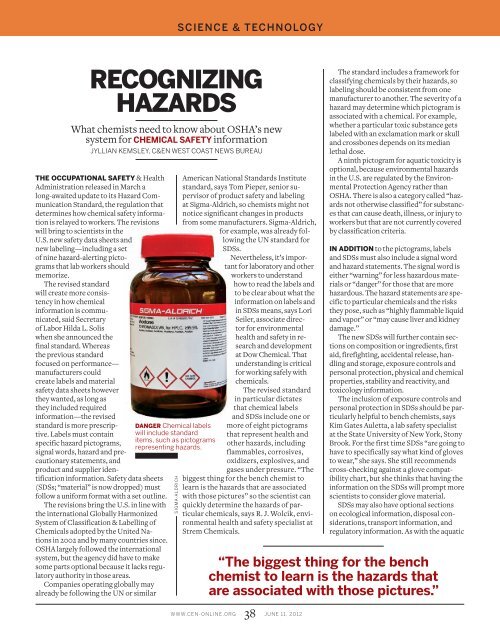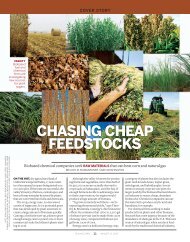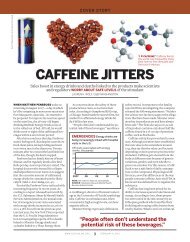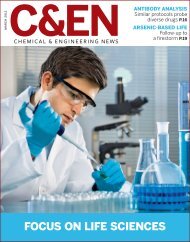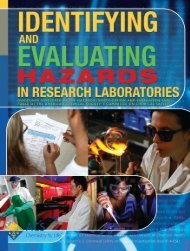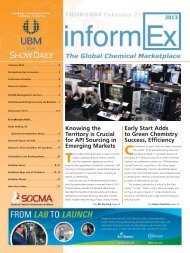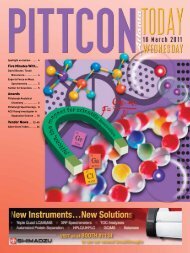RECOGNIZING HAZARDS - Chemical & Engineering News
RECOGNIZING HAZARDS - Chemical & Engineering News
RECOGNIZING HAZARDS - Chemical & Engineering News
You also want an ePaper? Increase the reach of your titles
YUMPU automatically turns print PDFs into web optimized ePapers that Google loves.
SCIENCE & TECHNOLOGY<br />
<strong>RECOGNIZING</strong><br />
<strong>HAZARDS</strong><br />
What chemists need to know about OSHA’s new<br />
system for CHEMICAL SAFETY information<br />
JYLLIAN KEMSLEY, C&EN WEST COAST NEWS BUREAU<br />
THE OCCUPATIONAL SAFETY & Health<br />
Administration released in March a<br />
long-awaited update to its Hazard Communication<br />
Standard, the regulation that<br />
determines how chemical safety information<br />
is relayed to workers. The revisions<br />
will bring to scientists in the<br />
U.S. new safety data sheets and<br />
new labeling—including a set<br />
of nine hazard-alerting pictograms<br />
that lab workers should<br />
memorize.<br />
The revised standard<br />
will create more consistency<br />
in how chemical<br />
information is communicated,<br />
said Secretary<br />
of Labor Hilda L. Solis<br />
when she announced the<br />
final standard. Whereas<br />
the previous standard<br />
focused on performance—<br />
manufacturers could<br />
create labels and material<br />
safety data sheets however<br />
they wanted, as long as<br />
they included required<br />
information—the revised<br />
standard is more prescriptive.<br />
Labels must contain<br />
specific hazard pictograms,<br />
signal words, hazard and precautionary<br />
statements, and<br />
product and supplier identification<br />
information. Safety data sheets<br />
(SDSs; “material” is now dropped) must<br />
follow a uniform format with a set outline.<br />
The revisions bring the U.S. in line with<br />
the international Globally Harmonized<br />
System of Classification & Labelling of<br />
<strong>Chemical</strong>s adopted by the United Nations<br />
in 2002 and by many countries since.<br />
OSHA largely followed the international<br />
system, but the agency did have to make<br />
some parts optional because it lacks regulatory<br />
authority in those areas.<br />
Companies operating globally may<br />
already be following the UN or similar<br />
DANGER <strong>Chemical</strong> labels<br />
will include standard<br />
items, such as pictograms<br />
representing hazards.<br />
SIGMA-ALDRICH<br />
American National Standards Institute<br />
standard, says Tom Pieper, senior supervisor<br />
of product safety and labeling<br />
at Sigma-Aldrich, so chemists might not<br />
notice significant changes in products<br />
from some manufacturers. Sigma-Aldrich,<br />
for example, was already following<br />
the UN standard for<br />
SDSs.<br />
Nevertheless, it’s important<br />
for laboratory and other<br />
workers to understand<br />
how to read the labels and<br />
to be clear about what the<br />
information on labels and<br />
in SDSs means, says Lori<br />
Seiler, associate director<br />
for environmental<br />
health and safety in research<br />
and development<br />
at Dow <strong>Chemical</strong>. That<br />
understanding is critical<br />
for working safely with<br />
chemicals.<br />
The revised standard<br />
in particular dictates<br />
that chemical labels<br />
and SDSs include one or<br />
more of eight pictograms<br />
that represent health and<br />
other hazards, including<br />
flammables, corrosives,<br />
oxidizers, explosives, and<br />
gases under pressure. “The<br />
biggest thing for the bench chemist to<br />
learn is the hazards that are associated<br />
with those pictures” so the scientist can<br />
quickly determine the hazards of particular<br />
chemicals, says R. J. Wolcik, environmental<br />
health and safety specialist at<br />
Strem <strong>Chemical</strong>s.<br />
WWW.CEN-ONLINE.ORG 38 JUNE 11, 2012<br />
The standard includes a framework for<br />
classifying chemicals by their hazards, so<br />
labeling should be consistent from one<br />
manufacturer to another. The severity of a<br />
hazard may determine which pictogram is<br />
associated with a chemical. For example,<br />
whether a particular toxic substance gets<br />
labeled with an exclamation mark or skull<br />
and crossbones depends on its median<br />
lethal dose.<br />
A ninth pictogram for aquatic toxicity is<br />
optional, because environmental hazards<br />
in the U.S. are regulated by the Environmental<br />
Protection Agency rather than<br />
OSHA. There is also a category called “hazards<br />
not otherwise classified” for substances<br />
that can cause death, illness, or injury to<br />
workers but that are not currently covered<br />
by classification criteria.<br />
IN ADDITION to the pictograms, labels<br />
and SDSs must also include a signal word<br />
and hazard statements. The signal word is<br />
either “warning” for less hazardous materials<br />
or “danger” for those that are more<br />
hazardous. The hazard statements are specific<br />
to particular chemicals and the risks<br />
they pose, such as “highly flammable liquid<br />
and vapor” or “may cause liver and kidney<br />
damage.”<br />
The new SDSs will further contain sections<br />
on composition or ingredients, first<br />
aid, firefighting, accidental release, handling<br />
and storage, exposure controls and<br />
personal protection, physical and chemical<br />
properties, stability and reactivity, and<br />
toxicology information.<br />
The inclusion of exposure controls and<br />
personal protection in SDSs should be particularly<br />
helpful to bench chemists, says<br />
Kim Gates Auletta, a lab safety specialist<br />
at the State University of New York, Stony<br />
Brook. For the first time SDSs “are going to<br />
have to specifically say what kind of gloves<br />
to wear,” she says. She still recommends<br />
cross-checking against a glove compatibility<br />
chart, but she thinks that having the<br />
information on the SDSs will prompt more<br />
scientists to consider glove material.<br />
SDSs may also have optional sections<br />
on ecological information, disposal considerations,<br />
transport information, and<br />
regulatory information. As with the aquatic<br />
“The biggest thing for the bench<br />
chemist to learn is the hazards that<br />
are associated with those pictures.”
QUICK LOOK<br />
New safety labels<br />
use pictograms that<br />
are designed for<br />
rapid recognition.<br />
SOURCE: OSHA<br />
◾◾<br />
Burns skin<br />
◾◾<br />
Damages eyes<br />
◾◾<br />
Corrosive to metals<br />
◾◾<br />
Explosive<br />
◾◾<br />
Self-reactive<br />
◾◾<br />
Organic peroxide<br />
◾◾<br />
Gas under pressure<br />
◾◾<br />
Toxic to aquatic life<br />
(optional)<br />
◾◾<br />
Carcinogen<br />
◾◾<br />
Mutagen<br />
◾◾<br />
Reproductive toxin<br />
◾◾<br />
Respiratory sensitizer<br />
◾◾<br />
Toxic to target organs<br />
◾◾<br />
Toxic if aspirated<br />
◾◾<br />
Acutely toxic (harmful)<br />
◾◾<br />
Irritant to skin, eyes, or<br />
respiratory tract<br />
◾◾<br />
Skin sensitizer<br />
◾◾<br />
Acutely toxic (severe)<br />
◾◾<br />
Flammable<br />
◾◾<br />
Self-reactive<br />
◾◾<br />
Pyrophoric<br />
◾◾<br />
Self-heating<br />
◾◾<br />
Emits flammable gas<br />
◾◾<br />
Organic peroxide<br />
◾◾<br />
Oxidizer<br />
toxicity pictogram, these sections are not<br />
required because they are beyond OSHA’s<br />
regulatory purview, but companies including<br />
them to conform to regulations in other<br />
countries won’t need to delete them for<br />
the U.S.<br />
ONE POTENTIAL POINT of confusion<br />
about the new hazard classes is that different<br />
types of hazards will be ranked by<br />
severity, starting with “1” as the most hazardous.<br />
But not all classes have the same<br />
number of ranking levels. Oxidizing gases<br />
are all categorized as “1,” for example,<br />
whereas flammable liquids are ranked into<br />
four categories, depending on their flash<br />
points. And the severities cannot be compared<br />
between hazard classes—one class’s<br />
category “1” is not necessarily more dangerous<br />
than another’s category “2,” Gates<br />
Auletta notes.<br />
The order of rankings is also the reverse<br />
of those used on U.S. National Fire Protection<br />
Association diamonds, which use<br />
“0” for least and “4” for most hazardous.<br />
Overall, the revised hazard communication<br />
standard will give chemical users<br />
“more complex but better, more thorough<br />
information,” says George Bleazard,<br />
Sigma-Aldrich’s corporate director of<br />
environmental health and safety, transportation<br />
compliance, and product safety.<br />
It is important for chemists and other<br />
employees to understand the new system<br />
and take advantage of that information for<br />
everyone’s safety ◾<br />
The Powerhouse for API Solutions<br />
F.I.S. – Fabbrica Italiana Sintetici S.p.A.<br />
Viale Milano, 26 - 36075 Montecchio Maggiore (Vicenza) - Italy<br />
www.fisvi.com<br />
WWW.CEN-ONLINE.ORG 39 JUNE 11, 2012


